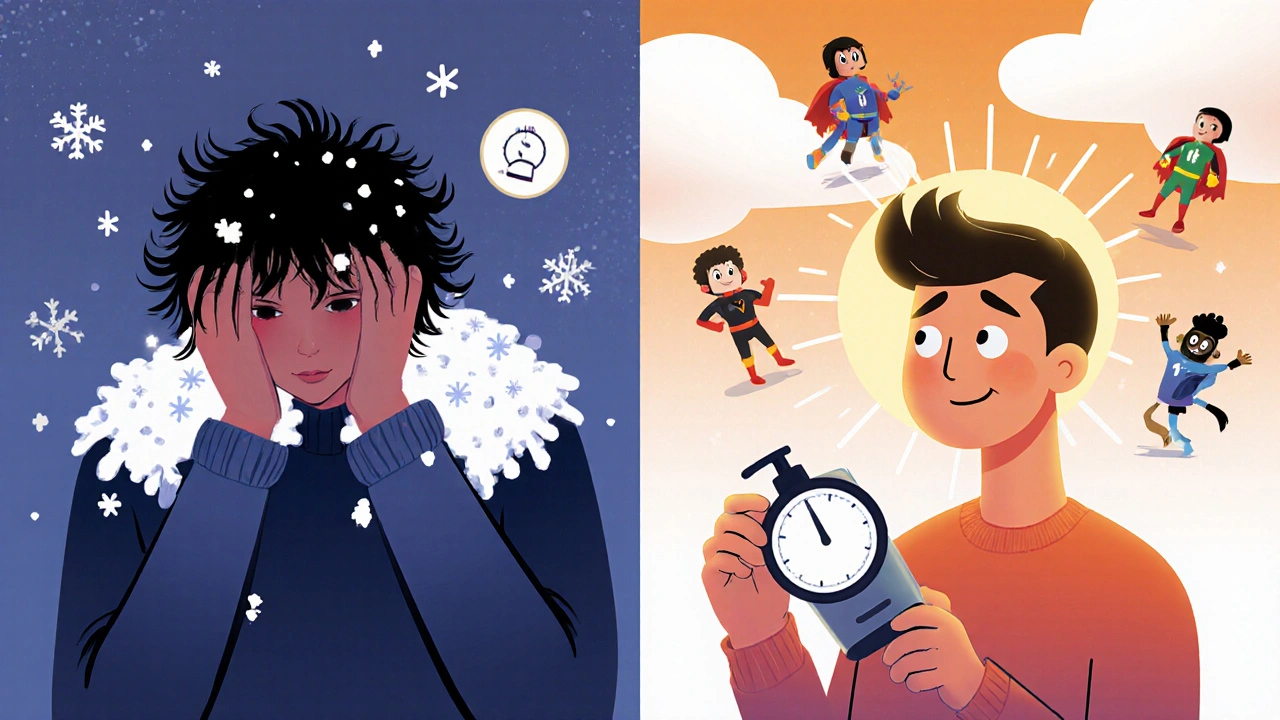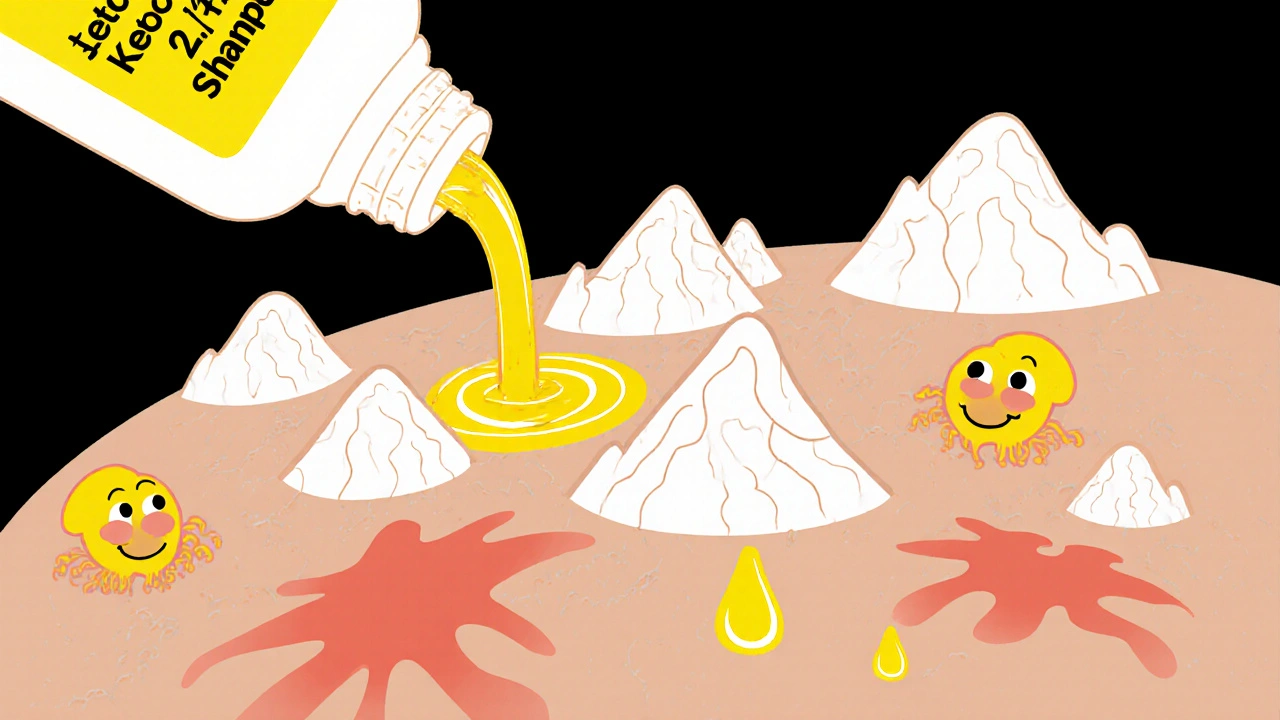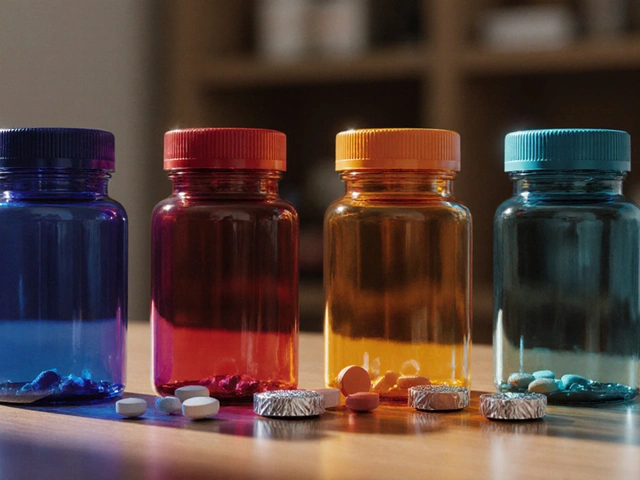Flakes on your shoulders, an itchy scalp, or oily patches behind your ears? You’re not alone. About 50% of adults will deal with seborrheic dermatitis at some point in their lives. It’s not dirt, not an allergy, and definitely not contagious. But it’s persistent - and frustrating. The truth? This isn’t just "bad dandruff." It’s an inflammatory skin condition triggered by a yeast called Malassezia that lives naturally on your skin. When it overgrows, it breaks down oils into irritating fatty acids, causing your scalp to shed skin cells too fast. The result? White or yellowish scales, redness, and that constant itch.
Why Your Scalp Keeps Flaking
Most people think dandruff is just dry skin. But seborrheic dermatitis is different. It thrives where your skin produces the most oil - scalp, eyebrows, nose creases, behind the ears. That’s why it’s so common in teens and adults. In babies, it’s called cradle cap, and it usually clears up on its own. But for adults? It’s a long-term game. The yeast Malassezia feeds on sebum, the natural oil your skin makes. When your body’s immune response overreacts to it, your skin cells multiply faster than normal and don’t shed properly. Instead of falling off one by one, they clump together into visible flakes. Stress, cold weather, and fatigue make it worse. Studies show 75% of people notice flare-ups in winter. That’s because dry air strips moisture, and less sunlight means less natural antifungal UV exposure. People with Parkinson’s disease are 4 to 5 times more likely to get it. So are those who use certain medications like lithium or interferon. Heavy alcohol use and obesity also raise your risk. But even if none of that applies to you, you can still get it. Genetics play a big role. If your mom had flaky eyebrows, you might too.What Works: The Medicated Shampoos That Actually Help
You don’t need a prescription to start treating this. Over-the-counter shampoos with proven ingredients can bring relief - if you use them right. Here’s what dermatologists recommend as first-line options:- Ketoconazole (2%) - The most effective antifungal. Kills Malassezia yeast directly. Brands like Nizoral are widely available.
- Zinc Pyrithione (1-2%) - Great for mild cases. Also has anti-inflammatory effects. Found in Head & Shoulders Clinical Strength and others.
- Selenium Sulfide (2.5%) - Slows skin cell turnover and reduces yeast. Selsun Blue is the most common brand.
- Cyclepirox (1%) - Strong antifungal and anti-inflammatory. Often prescription-only, but some OTC versions exist.
- Coal Tar (0.5-5%) - Slows down skin cell production. Smells strong, but works well for stubborn cases. Neutrogena T/Gel is a popular choice.
- Salicylic Acid (1.8-3%) - Exfoliates flakes. Helps other ingredients penetrate. Often paired with other actives.
How to Use These Shampoos (So They Actually Work)
Most people wash their hair and rinse. That’s why these shampoos fail for them. You need to leave them on. Apply the shampoo directly to your scalp - not just your hair. Massage it in gently. Let it sit for 5 to 10 minutes before rinsing. This gives the active ingredients time to work. If you rinse too soon, you’re washing away the treatment. Start with daily or every-other-day use until flakes and redness fade - usually within 2 to 4 weeks. Once symptoms improve, switch to maintenance: once or twice a week. Stop too soon, and the yeast comes back. In fact, most people see flare-ups within 2 to 4 weeks after stopping treatment.What to Do When One Shampoo Stops Working
Here’s the hard truth: your body gets used to them. After a few months, ketoconazole might stop working as well. That’s normal. The solution? Rotate. Use one shampoo for 4 weeks. Then switch to another. For example:- Weeks 1-4: Ketoconazole
- Weeks 5-8: Selenium sulfide
- Weeks 9-12: Coal tar
- Repeat

When to Add a Topical Steroid
If your scalp is red, swollen, and burning, you might need help calming the inflammation. That’s where hydrocortisone cream comes in. A 0.5% or 1% hydrocortisone cream (available OTC) can be applied sparingly to the affected scalp areas - not your hairline, just the skin. Use it for no more than 5 to 7 days at a time. It’s not for daily use. It’s a short-term fix to break the itch-scratch cycle while the shampoo does its job. Don’t use it on your face unless directed by a doctor. For facial seborrheic dermatitis (like on eyebrows or beard), shaving can help. One study found 37% of men cleared their symptoms just by shaving and using antifungal washes.Side Effects You Should Know
These shampoos aren’t perfect.- Dry hair - Happens to 41% of users. Use a gentle conditioner on the ends, not the scalp.
- Strong smell - Coal tar and selenium sulfide smell like chemicals. Some people can’t tolerate it.
- Initial worsening - In the first week or two, your scalp might get flakier. That’s your skin shedding the built-up scales. Stick with it.
- Discoloration - Selenium sulfide can lighten dyed hair. Avoid if you color your hair.
What Doesn’t Work
Don’t waste your time on these:- Apple cider vinegar rinses - No clinical proof. Might irritate your scalp.
- Tea tree oil shampoos - Some people like them, but studies show inconsistent results. Not reliable.
- More frequent washing - Washing daily without medicated shampoo just dries you out.
- Anti-dandruff shampoos with only zinc pyrithione at 0.5% - Too weak. Look for 1-2%.

Long-Term Management Is the Goal
There’s no cure for seborrheic dermatitis. But you can control it. For life. Think of it like managing high blood pressure. You don’t take a pill once and call it done. You keep taking it. Same here. Even when your scalp looks perfect, keep using the shampoo once or twice a week. That’s maintenance. If you stop, the yeast will bounce back. Flakes will return. It’s not your fault. It’s biology. The best outcomes come from people who treat this like a chronic condition - not a one-time problem. Keep a bottle of ketoconazole or zinc pyrithione in your shower. Use it every other week. That’s all it takes to stay clear.When to See a Dermatologist
You don’t need to see one right away. But if:- Your scalp is bleeding or oozing
- Flaking spreads to your face, chest, or back
- Over-the-counter shampoos do nothing after 6 weeks
- You’re losing hair in patches
Real Talk: What People Actually Experience
People on forums like Reddit’s r/skincareaddiction say the same thing: "It took me 8 months to figure this out. I tried 5 shampoos. I almost gave up. Then I rotated ketoconazole with tar - and it finally stopped. Now I use it twice a week. No more flakes. No more itching. Just normal hair." It’s not glamorous. It’s not quick. But it works. Start with one medicated shampoo. Leave it on for 10 minutes. Use it 3 times a week. Wait 4 weeks. If nothing changes, switch. Keep track. Be patient. Your scalp isn’t broken. It’s just reacting to a yeast it can’t ignore. And with the right routine, you can quiet it down - for good.Is seborrheic dermatitis the same as dandruff?
Dandruff is a mild form of seborrheic dermatitis that only affects the scalp. Both involve flaking, but seborrheic dermatitis can also cause redness, greasy scales, and affect areas like the eyebrows, nose, and ears. If your flaking is only on your scalp and not accompanied by redness or itchiness, it’s likely just dandruff. If it’s worse in winter, spreads beyond the scalp, or doesn’t respond to regular shampoo, it’s probably seborrheic dermatitis.
Can stress make seborrheic dermatitis worse?
Yes. Stress triggers flare-ups in about 60% of people with seborrheic dermatitis. When you’re stressed, your body releases hormones that can increase oil production and weaken your skin’s barrier - giving the Malassezia yeast more room to overgrow. Managing stress through sleep, exercise, or mindfulness can help reduce how often and how badly you flare up.
Why does my scalp get worse in winter?
Cold, dry air strips moisture from your skin, making your scalp more sensitive. Less sunlight also means less natural UV light, which helps control the Malassezia yeast. Indoor heating dries things out even more. That’s why 65% of people notice worse symptoms in winter. Using a humidifier and sticking to your medicated shampoo routine helps.
Can I use medicated shampoo every day?
Yes - but only during the initial treatment phase. Use daily or every other day for 2 to 4 weeks to get symptoms under control. Once your scalp improves, switch to maintenance: once or twice a week. Daily use long-term can dry out your hair and scalp. If your hair gets too dry, use a moisturizing conditioner on the ends only.
Do I need to use these shampoos forever?
You don’t need to use them daily forever, but yes - you’ll need to keep using them occasionally for life. Seborrheic dermatitis can’t be cured, only managed. If you stop completely, flakes and itching usually return within 2 to 4 weeks. Think of it like brushing your teeth: you don’t do it once and expect to never have cavities again. Same here. Weekly use keeps the yeast in check.
Can I use these shampoos if I color my hair?
Some can. Ketoconazole and zinc pyrithione are generally safe for colored hair. But selenium sulfide and coal tar can lighten or dull hair color over time. If you color your hair, avoid those two unless you’re okay with potential fading. Always patch-test new shampoos on a small section first.
Will shaving my head help with scalp seborrheic dermatitis?
Shaving your head won’t cure it, but it can make treatment easier. Without hair, you can apply shampoo directly to the scalp and rinse more thoroughly. It also reduces the surface where yeast and flakes can hide. For people with severe cases, shaving can speed up improvement - but you still need to use medicated shampoo regularly, even on a shaved scalp.
Start with a ketoconazole or zinc pyrithione shampoo. Leave it on for 10 minutes. Use it 3 times a week. Wait. Adjust. Rotate. Stay consistent. Your scalp doesn’t need miracles - it needs a smart, steady routine.



dace yates
10 November / 2025I’ve been dealing with this for years and honestly, the rotation trick was a game-changer. I was using ketoconazole every day until my hair felt like straw, then switched to selenium sulfide for two weeks-suddenly, the flakes were gone. Didn’t even realize how much I’d been scratching until it stopped.
Now I do ketoconazole every other Sunday and zinc pyrithione midweek. No more shoulder flakes, no more embarrassing moments in meetings. It’s not glamorous, but it works.
Also, I started using a humidifier in winter. Huge difference. The dry heat in my apartment was basically feeding the yeast.